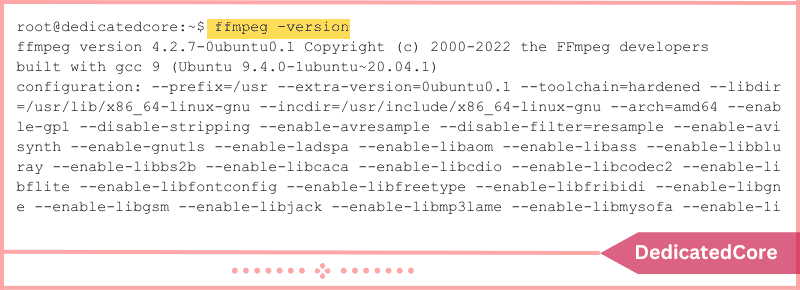Users who install FFmpeg on Ubuntu have access to a robust multimedia framework that makes it simple to convert, record, and stream audio and video files. A versatile tool for developers, content creators, and multimedia fans alike, FFmpeg offers a wide range of features. This tutorial will walk you through the quick steps needed to install FFmpeg on your Ubuntu system, opening up a vast array of media processing and modification options.
Experience the fastest and most secure online business with our dedicated server’s pre-tested top-quality hardware in UK which is the top choice provider. Multimedia content can be recorded, transcoded, mixed, formatted, and streamed using the command-line utility FFmpeg. The open-source, cross-platform frameworks libavutil, libavcodec, libavformat, libavdevice, libavfilter, libswscale, and libswresample freely distribute audio and video libraries to users. To set up a user-friendly and efficient web hosting control panel on your server, explore our detailed manual on installing VestaCP on Ubuntu.
Install FFmpeg on Ubuntu using apt
The FFmpeg package is available in the Ubuntu repository, albeit it might not be the most recent version. Although it is one of the simplest ways to install FFmpeg on Ubuntu, apt is still often used. With vps hosting in USA you can get quality server configuration but colocates it for uninterrupted network and huge storage.
Step 1: Before you Start, the First thing to do is Update the Repository
To use the most recent FFmpeg version available in the repository, update and upgrade the system packages. Put this command into action:
sudo apt update && sudo apt upgrade

To continue Press y when prompted:
Step 2: After Successful with the First step, Install FFmpeg
Install FFmpeg by performing the following after updating the repository:
sudo apt install ffmpeg

Step 3: Check over the Installation
Verify that FFmpeg has been set up using:
ffmpeg -version

The command confirms that FFmpeg version 4.2.7 is installed. The most recent stable FFmpeg version in the Ubuntu 20.04 repositories is 4.2.7. However, the software in the Ubuntu repositories is only sometimes current.
Install FFmpeg with Snappy.
Utilize the Snap package manager (snappy) to download the most recent version of FFmpeg. A program and its dependencies are packaged together by the snap tool in a container known as a snap package that runs on any Linux system. Snaps are updated automatically and continuously, unlike FFmpeg packages in the official Ubuntu repository, guaranteeing users the most recent FFmpeg version.
Step 1: Set up Snap
As with Ubuntu, start by determining whether Snap is installed on the machine. Take the following actions:
snap version

The output demonstrates that Snap is operational. If Snap is not installed on Ubuntu, the following is printed by the command:

Follow these Steps to Add Snap to the Device:
1. Improve and update the repository using:
sudo apt update && sudo apt upgrade

2. By Running the Command Install Snap
sudo apt install snapd

3. Checking Installation:
snap version

Step 2: Install FFmpeg
Run the following command to install FFmpeg:
sudo snap install ffmpeg

The progress bar is shown on the terminal. When the installation is finished, the result appears as follows:

Step 3: Recheck the Installation
Run the following Command to recheck the Installation
ffmpeg -version

The FFmpeg version installed using Snap is 4.3.1, more recent than the version installed using apt (4.2.7).
Final Thoughts on Installing FFmpeg on Ubuntu
Ubuntu users have many options for productively working with multimedia files after installing FFmpeg. You can use FFmpeg to easily convert, record, and stream audio and video content. If you are looking to keep complicated data and construct scalable applications installing MongoDB on Ubuntu will be useful.
The adaptable features of FFmpeg will surely come in handy in your multimedia pursuits. Whether you’re a content creator, developer, or just someone who wishes to improve their media capabilities. Now that FFmpeg is up and running on Ubuntu. You should investigate its features to unleash your creativity and get the most out of your multimedia experience.
Frequently Asked Questions (FAQ)
1. What is FFmpeg and why is it used?
FFmpeg is a powerful multimedia framework that allows you to do multiple tasks on almost any type of audio and video file. It’s commonly used for video conversion, streaming, and editing.
2. What are the Prerequisites for Installing FFmpeg on Ubuntu?
With the below commands make sure your system is updated:
sudo apt update sudo apt upgrade

